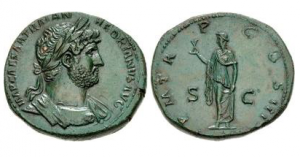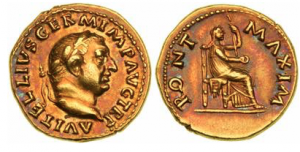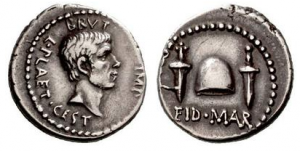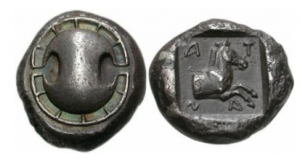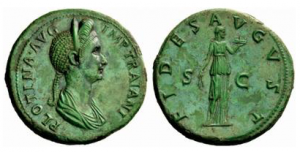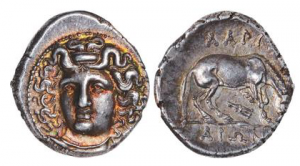Americans expressed their reaction to the Cold War era through a variety of architectural designs. While Russia’s austere cement structures depicted the defensive stance of rival nations, Californian architecture created space-age structures to show society’s interest in science and technology. Southern California in particular became known for the Googie style that was recognized mainly by its futuristic elements. For example, the LAX theme building, known for its flying saucer shape, even today remains a well-recognized Googie design.(Peregoy) While some reviewers considered Googie just cheap gaudy art, Googie reflected society’s concerns with the Space Race, arms buildup, civil rights and technology.
In 1952, Douglas Haskell, a prominent architectural writer, applied the term Googie to a whole segment of architecture that was reminiscent of the original Googie’s coffee shop. (Hess 61) Haskell observed that the futuristic style of Googie’s coffee shop became a popular design appearing in many California structures. Googie designs took on the spirit of the space age, as structures resembled flying saucers, rockets and starbursts. (Valerie) Another key aspect of Googie was the use of curved contours inspired by atomic science and amoebas. (Hess 50)(Ulaby) A feature that separated Googie from earlier styles was the use of previously unorthodox materials such as asbestos, cement, glass block, plastic and plywood. (Hess 62) While some reviewers looked down on the Googie style as too flamboyant, Googie was a design that Americans embraced. Southern California has several buildings that are renowned examples of the Cold War Googie architecture. Norm’s restaurants has pylon signs that resemble rockets and the Union 76 Station in Beverly Hills has a sleek undulating roof.(Peregoy) In 1955, Southern California’s Disneyland solidified America’s interest in the future through the opening of Tomorrowland, filled with Googie’s space age designs.(Hess 47)
Simply by viewing a Googie structure, Americans were inspired to embrace technology and contemplate the future. Technology experienced a rebirth during the Cold War era and focused on atomic energy, space travel and consumer products. (Hess 33) The arms race meant weapons of mass destruction were continually being updated and the Space Age fostered various scientific innovations. It is not surprising that Googie style was highly associated with Southern California, as this region already supported innovation through various industries that included television, aerospace and defense. (Gammon) Additionally, Southern California’s strong car culture was intrigued by Googie’s attention to automobiles. In the post-WWII years there was an explosion of automobiles and American consumers embraced advances in automobiles. (Rapaort 46) Cars became so prominent during this era that they were one reason the interstate highway system was established. (Rapaort 46) Googie focused on the automobile segment of society through structures that easily attracted drivers. Southern California in particular welcomed signage that could be viewed from cars and carwashes with futuristic starbursts. Googie had the opportunity to become an effective roadside advertiser, influence Ford’s “Mystere” and inspire the “tail fin.” (Hess 55, 57)
While technology was Googie’s most recognizable feature, Googie also addressed important social issues. Googie offered the ideal of equality that was becoming part of Cold War policies. Eventually the landmark Civil Rights Act of 1964 would end segregation in public areas including schools, restaurants and buses. (Yeager) Even though the Civil Rights Act required non-discrimination practices, there was still opposition. For example, Ollie’s BBQ in Birmingham was still a segregated establishment as the restaurant owners did not believe in federal interference. (Yeager) While racist practices dominated the South, the story was much different in Googie establishments. Located primarily in Southern California, Googie restaurants were far from the epicenter of racism. Googie restaurants were democratic in nature. All patrons read the same menu and no seat was better than another. (Nichols 6) Even though racism was minimal at Googie restaurants, they still primarily catered to whites due to their mostly suburban locations. In the 1950’s America began to experience “White Flight” and minorities were more centered in urban areas. (Semuels)
Googie’s association with equal opportunity was also demonstrated by the public access to their designs. In the post-WWII years, the arts were becoming an important luxury of society and the United States had “leadership in world as well as arts.” (Rapaport 25) A key difference between high-art and Googie was that Googie exposed many more to its style of architecture while high-art was selectively focused on elites. (Hess 51) (Semuels) The Googie style was democratized, as the futuristic exteriors were available for any passerby to experience, whether they were a minority or white, rich or poor. The distinctive large pylon signs and domed ceilings were located on major thoroughfares, not just upper class neighborhoods. When gazing at the sparkling glass windows at Pann’s Restaurant any individual could be inspired to dream of America’s bright future. (Peregoy) Even though more people had the opportunity to experience art through Googie than through traditional high-art, initially Googie was not a respected art form. (Nichols 13) (Hess 61) Googie was seen as over commercialized and gaudy. Hess even states that Googie had “advertising function central to its art” and Googie was “unashamed commercialism.” (Hess 25)
In addition to social issues, Googie style addressed the general mistrust that plagued the Cold War era. On the international scale there was much tension between the US and USSR rivals. Each side aimed to monitor the other and this was primarily evident in the proliferation of espionage. Average Americans experienced the mistrust of the times by watching the high profile Julius and Ethel Rosenberg trials and the shooting down of the U2 spy plane. Even McCarthyism added to the mistrust as the motivations of Hollywood titans were questioned on the national stage. Due to the times, average Americans wanted increased transparency. In the Googie establishment transparency was a key tenet. Innovations in molding glass allowed glass to be widely used on Googie restaurants. (Hess 56). The extensive use of windows allowed customers to view the interior of the restaurant from outside. The customers could experience the restaurant atmosphere even before entering. Additionally, “exhibition cooking” was implemented inside. (Hess 68) “Exhibition cooking” allowed the restaurant customers to watch their food get made. Even though the mood outside the restaurants was of mistrust, when visiting the Googie restaurants there was a breath of fresh air. Googie was not hiding any secrets. The same could not be said for the geopolitical events of the era.
Googie design provided an escape from the serious threats of war and doom that existed during the Cold War. Both sides of the Iron Curtain maintained immense nuclear arsenals and the threat of nuclear holocaust remained a very real possibility. Perhaps the height of such tensions was 1962’s Cuban missile crisis. Besides merely hearing about the weapons threats via the news, many Americans were profoundly impacted by the geopolitical events. School children had to partake in air raid drills and many adults opted to build bomb shelters. Due to the tense atmosphere of the times, Americans sought emotional outlets. One way Americans had an escape was through the Googie restaurants. Instead of worrying about a nuclear holocaust, average Americans could go to McDonald’s golden arches and enjoy an inexpensive hamburger. The idea of escaping the tense times even expanded to non-restaurant Googie establishments. Americans could visit Wayne McAllister’s Sands Hotel in Las Vegas. (Nichols 137) Even though the hotel represented leisure and not the tense times, the Sands featured a mural of an atomic blast that served as an eerie reminder of the larger era. (Nichols 144)
An even greater reminder of the tensions was the Brutalist structures that gained prominence during the early Cold War era. Brutalism was marked by the use of bland concrete and lacked the Googie’s biomorphic shapes. (Lebowitz) While the Googie embodied futurism, the Brutalist embodied bomb shelters or even the USSR’s bland apartment blocks. The Brutalist structures served as reminder that the world was not quiet as glamorous as Googie architecture would lead people to believe. The Brutalist establishments echoed the undercurrent of the times. Even though there was much progress during the Cold War era there were still problems such as the threat of nuclear war. While Googie was meant primarily for commercial ventures and later some homes, Brutalism included skyscrapers, banks, libraries and city halls. (Dunning) Googie was culturally represented in The Jetsons where as Brutalism was perhaps best portrayed in dystopian works such as the movie Blade Runner. (Meades)
While Googie coffee shops represented the consumerism of the Cold War era, Eichler homes represented a different facet of Cold War America. Eichlers emerged at a time when there was a mass exodus of army veterans. With items such as the GI Bill, these veterans strived to live the American Dream. Along with owning a car, veterans also wanted to own a house. Eichler tract homes, built in Northern California, Southern California and New York, were one way to satisfy the needs of post-WWII America. (Reggev) In California the futuristic home style appealed to a relatively hi-tech community that included aerospace engineers working on space and defense projects. (Gammon) Besides the low cost of building, the Eichlers were extremely popular due their innovative designs. Eichlers brought modernity to the masses and utilized an indoor-outdoor type living. (Park) Such traits of Eichlers were reminiscent of their contemporary commercial buildings, the Googie coffee shops. Eichlers followed the ideals of transparency, similar to the exhibition cooking. The open floor plans created one large area that contained the kitchen, dining room and living area. The homes were also admired for their connection to the outside that was created by expansive glass walls. Another important and unique aspect of Eichler homes was their socioeconomic openness. In an era of extreme racism and segregation, Joseph Eichler allowed his homes to be available to anyone. (Tanjuatco) This is significant because during the Cold War era there was “white flight” which was marked by Caucasians leaving the inner cities for the suburbs. (Semuels) Such racial openness of the Eichlers demonstrated that “white flight” was not necessarily a reality in the whole of the United States. It is refreshing to know that in an era of extreme prejudice there were beacons of hope such as Joseph Eichler. In a discussion of the civil rights era usually he is an overlooked figure.
While Googie style was mainly limited to Southern California, the rest of the United States and the world got a glimpse of Googie through The Jetsons TV show. Originally airing from 1962 to 1963 the Jetsons were a futuristic cartoon family. Their transportation was reminiscent of Ford’s Mystere and their buildings harkened to the famed Googie coffee shops. The Jetsons’ buildings were distinctly American and a sharp contrast to the buildings on the other side of the Iron Curtain. In Russia meanwhile, the Soviets lived in lifeless apartment blocks. (Meades) The Jetsons’ glamorous architecture represented the fruits of a democratic society. The show’s buildings had extensive use of modern glass, organic forms and indoor-outdoor living. Another important aspect of The Jetsons is that the show shared the Googie architecture with all ages. While coffee shops were mostly for older generations, the cartoon appealed to children. The Jetsons occurred in an era of technological optimism as the Space Age was just getting started. Such optimism was evident in the show as there were robotic servants and flying cars. Despite the progress shown in the series the future was still depicted with the minor inconveniences of actual everyday life, such as traffic and family issues. The Jetsons made no reference to Cold War threats even though the Cuban missile crisis occurred in October 1962.
The Jetsons was not the only entity that spread Googie beyond the bounds of Southern California. McDonalds’ Googie style structures expanded throughout the United States and eventually the world. The original McDonalds locations utilized signature Googie glass and the famed golden arches that were very similar to the distinctive Googie pylon signs. (Hess 100) McDonalds represented the consumerism of the times. Domestically, the United States prospered. Between 1945 and 1949 Americans purchased 21.4 million cars and 20 million refrigerators. (PBS) As suburbia spread, individuals strived to live the American Dream and many had an exposable income to spend. Going to McDonalds was an activity that appealed to the whole family. The innovative fast service catered to Americans with busy lives while Ronald McDonald and Happy Meals attracted children. McDonalds also reflected the Cold War’s fascination with technology. McDonalds was technologically advanced in the regard they revolutionized restaurant efficiency. For example, the McDonalds kitchens were designed for speed. (Hess 99) While the original Jetsons TV series ended after a couple of years, McDonalds would outlast the Cold War era. McDonalds demonstrated that in a capitalistic society, the most engaging companies succeed and prosper. McDonalds today operates across numerous continents and remains a symbol of America. Today, many McDonalds no longer use the traditional Googie glass, but the golden arch pylons have stood the test of time.
Eventually in the late 1960s Googie was phased out. The new era of buildings, in stark contrast to Googie, tried to blend in. (Hess 121) The post-Googie buildings also utilized different materials such as brick, wood shingles and mansard roofs. (Hess 121) For a brief time, even a Polynesian style emerged. (Hess 121) Along with the new forms of buildings came the destruction of the Googie establishments. Many of the Googie buildings fell victim to high property values and were razed for more economically efficient use. For example, of the original 1000 McDonalds restaurants, only 12 survived in 1984. (Hess 122) Although it is disheartening for the Googie buildings to be destroyed, such actions are indicative of the American capitalist society. Despite the trend of Googie destruction, there has been some effort to preserve the buildings. In 1984, the original McDonalds in Downey became eligible for the National Registration of Historic Places. (Hess 123) In more recent years, there has also been a movement to preserve the Cold War era Eichler tract homes in places such as Orange, California (Park). In fact there has been such a longing for Eichlers that new 21st century versions of them are being constructed in the San Francisco Bay Area. (Blitzer) Brutalist buildings with relatively nondescript gray facades have been much more timeless than the Googie’s space-like structures. As a result the Brutalists have better stood the test of time and have not been torn down to Googie’s extent. In the suburbs outside of New York City, there has even been an active movement to further preserve the Brutalist buildings as historical landmarks. (Hay)
In an era of modernity, Googie architecture depicts the historic elements of Cold War structures from the past. Today, the LAX theme building embodies the spirit of Googie style and its uniqueness attracts the passerby’s attention, no pylon signage needed. (Peregoy) Even though the structure no longer operates as a public restaurant, the building embodies how California embraced the Space Age, arms race and civil rights movement. Fortunately, several Googie coffee shops exist today and they can offer throwback moments to true Cold War experiences. When one sits at the open counter of a still existing Googie establishment it is easy to image the members of the Greatest Generation discussing the Cuban missile crisis or maybe even the Dodgers’ move to LA.
Works Cited
Blitzer, Carol. “Real Estate: The Rebirth of the Eichler.” Palo Alto Online, 15 Feb. 2013, www.paloaltoonline.com/news/2013/02/15/real-estate-the-rebirth-of-the-eichler.
Ference, Audrey. “What Are Eichler Homes? Mid-Century Modern Architectural Gems, That’s What>.” Real Estate News and Advice | Realtor.com®, Realtor.com, 27 Feb. 2018, www.realtor.com/advice/buy/what-are-eichler-homes/.
Gammon, Katharine. “Trojans Help Launch New Era for Space Industry in Los Angeles.” USC News, news.usc.edu/trojan-family/space-industry-los-angeles-usc/.
Hay, David. “Defending Brutalism | National Trust for Historic Preservation.” Defending Brutalism | National Trust for Historic Preservation, 1 Jan. 2013, savingplaces.org/stories/defending-brutalism#.XMZTopNKj6Z.
Hess, Alan. Googie: Fifties Coffee Shop Architecture. Chronicle, 1985.
Hess, Alan. Googie Redux: Ultramodern Roadside Architecture. Chronicle Books, 2004.
Lebowitz, Rachel. “10 Bold Icons of Brutalist Architecture.” Artsy, 5 Aug. 2016, www.artsy.net/article/artsy-editorial-10-icons-of-brutalist-architecture.
Meades, Jonathan. “The Incredible Hulks: Jonathan Meades’ A-Z of Brutalism.” The Guardian, Guardian News and Media, 13 Feb. 2014, www.theguardian.com/artanddesign/2014/feb/13/jonathan-meades-brutalism-a-z.
Nichols, Chris. The Leisure Architecture of Wayne McAllister. Gibbs Smith, 2007.
Novak, Matt. “Googie: Architecture of the Space Age.” Smithsonian.com, Smithsonian Institution, 15 June 2012, www.smithsonianmag.com/history/googie-architecture-of-the-space-age-122837470/.
Park, Jeong. “Orange’s Eichler Tracts Designated as Historic District to Help Preserve the Homes’ Signature Style.” Orange County Register, Orange County Register, 30 Nov. 2018, www.ocregister.com/2018/11/30/oranges-eichler-tracts-designated-as-historic-district-to-help-preserve-the-homes-signature-style/.
Peregoy, Beau. “5 Of the Best Googie Buildings in L.A.” Architectural Digest, Architectural Digest, 21 Dec. 2016, www.architecturaldigest.com/gallery/googie-buildings-la.
Rapaport, Brooke Kamin., and Kevin L. Stayton. Vital Forms: American Art and Design in the Atomic Age, 1940-1960 ;Harry N. Abrams, 2001.
Reggev, Kate. “Homes by Joseph L. Eichler – What Are Eichlers and Why Do People Love Them?” Dwell, 28 Feb. 2019, www.dwell.com/article/california-midcentury-homes-joseph-l-eichler-ffabed74.
Semuels, Alana. “White Flight Lives on in American Cities.” The Atlantic, Atlantic Media Company, 30 July 2015, www.theatlantic.com/business/archive/2015/07/white-flight-alive-and-well/399980/.
Tanjuatco, Leora. “They Like Eich.” Curbed, Curbed, 23 Sept. 2015, www.curbed.com/2015/9/23/9919100/joseph-eichler-midcentury-houses.
“The Rise of American Consumerism.” PBS, Public Broadcasting Service, www.pbs.org/wgbh/americanexperience/features/tupperware-consumer/.
Ulaby, Neda. “Out Of This World: Designs Of The Space Age.” NPR, NPR, 14 July 2011, www.npr.org/2011/07/14/137763046/out-of-this-world-designs-of-the-space-age.
Valerie J. Nelson, Los Angeles Times. “Eldon Davis Dies at 94; Architect Designed ‘Googie’ Coffee Shops.” Los Angeles Times, Los Angeles Times, 26 Apr. 2011, www.latimes.com/local/obituaries/la-xpm-2011-apr-26-la-me-eldon-davis-20110426-story.html.
Yeager, Andrew. “Forced To Seat Blacks, Ala. Restaurant Complied With History.” NPR, NPR, 13 Dec. 2014, www.npr.org/2014/12/13/370470745/forced-to-seat-blacks-ala-restaurant-complied-with-history
